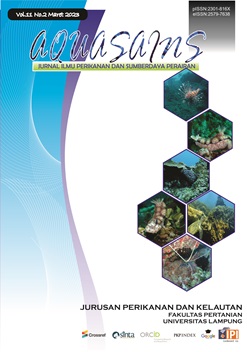ADDITION OF FERMENTED Eucheuma cottoni SEAWEED FLOUR WITH FERMENTER EM-4 IN TILAPIA (Oreochromis niloticus) COMMERCIAL FEED
DOI:
https://doi.org/10.23960/aqs.v11i2.p1311%20-%201320 Abstract View: 328
Abstract View: 328
Abstract
The purpose of this study was to analyze the addition of fermented E cottoni seaweed flour with the EM-4 fermenter in commercial tilapia feed. This research was conducted for 50 days at the Fish Production and Reproduction Laboratory, Faculty of Agriculture, University of Mataram, while for proximate analysis it was carried out at the Laboratory of Nutrition and Animal Feed Sciences, University of Mataram. The research method used was an experimental method with a completely randomized design (CRD), consisting of 4 treatments and 3 replications with the addition of seaweed flour 0%/kg, 10%/kg, 20%/kg, and 30%/kg of commercial feed. Parameters measured were absolute length absolute weight, specific growth rate, feed utilization efficiency ratio (EPP), feed conversion ratio (FCR), survival rate, and water quality. Data were analyzed using the ANOVA test at the 5% level. Then proceed with Duncan's test level of 5%. The results showed that the addition of different concentrations of EM-4 fermented E. cottoni seaweed flour to commercial feeds could affect growth, EPP, and FCR, but did not affect the survival rate of tilapia. The addition of E. cottoni seaweed powder fermented by EM4 at a concentration of 20% could increase the absolute weight, absolute length, specific growth rate, EPP, and FCR of tilapia which were better than the control treatment, which were respectively 7.44 g, 3, 48 cm, 2.31%/day, 93% and 1.2.
Downloads
References
Adriani, Y., Setiawati, M., dan Sunarmo. (2018). Kecernaan Pakan dan Kinerja Pertumbuhan Ikan Gurami (Ospronemus gorami) Yang diberi Pakan dengan Penambahan Glutamin. Jurnal Ikhtiologi Indonesia 19 : 1-11.
Agusman, Apriani. S. N. dan K, Murdinah. (2014). Penggunaan Tepung Rumput Laut Eucheuma cottonii pada Pembuatan Beras Analog dari Tepung Modified Cassava Flour (MOCAF). JPB Perikanan 9 : 1–10.
Al Barru N. A., S. Y. Lumbessy &. D. P. Lestari. (2022). The Composition Test Of Tilapia Feed (Oreochromis Niloticus) With Addition Of Flour E. Cottonii Fermented Using Tape Yeast and EM-4. AQUASAINS (Jurnal Ilmu Perikanan dan Sumberdaya Perairan), 11 (1) : 1159 -1166
Angriani, Reski., Irman H., dan Harfika S. B. (2020). Analisis Pertumbuhan dan Kelangsungan Hidup Benih Ikan Nila Salin (Oreochromis nilotius, Linn) dengan Dosis Pakan yang Berbeda. Fisheries of Wallacea Journal, 1(2): 84-92.
Aslamyah. S, Karim. M. Y, dan Badraeni. (2017). Fermentasi Tepung Rumput Laut dengan Berbagai Fermentor untuk Meningkatkan Kualitas Sebagai Bahan Baku Pakan Ikan. Jurnal Akuakultur Indonesia 16 : 8–14.
Cokrowati, N., Lumbessy, S. Y., Diniarti, N., Supiandi, M., & Bangun, B. (2020). Kandungan Klorofil-a dan Fikoeritrin Kappaphycus alvarezii Hasil Kultur Jaringan dan dibudidayakan pada Jarak Tanam Berbeda. Jurnal Biologi Tropis, 20(1), 125-131.
Endraswari, L. P. M., Nunik, C., dan Salnida, Y. L . (2021). Fortifikasi Pakan Ikan dengan Tepung Rumput Laut Glacilaria sp. pada Budidaya Ikan Nila (Oreochromis niloticus). Jurnal Kelautan 14 : 70-81
Fadlatul, A, Lumbessy, S. Y, & Lestari, D. P (2022). Pemanfaatan Tepung Rumput Laut Eucheuma Cottonii Terfermentasi Pada Pakan Budidaya Ikan Nila (Oreochromis niloticus). Barakuda 45, 4 (2), 101-114
Firdaus, I., Hilyana, S., & Lumbessy, S. Y. (2013). Pengaruh Padat Tebar terhadap Pertumbuhan dan Kelangsungan Hidup Abalon Dihibrid (Haliotis sp.) yang Dipelihara di Rakit Apung. Jurnal Perikanan Unram, 1(2), 7-13.
Handajani, H. (2011). Optimalisasi Tepung Azolla Terfermentasi pada Pakan Ikan untuk Meningkatkan Produktivitas Ikan Nila Gift. Jurnal Teknik Industri 12 :177-181
Irmadiati, I., Lumbessy, S. Y., & Azhar, F. (2021). Pengaruh Penambahan Tepung Rumput Laut Eucheuma spinosum pada Pakan Terhadap Pertumbuhan dan Kelangsungan Hidup Ikan Mas (Cyprinus carpio). Acta Aquatica: Aquatic Sciences Journal, 8(3), 146-153.
Iskandar., Ayu, M., Ibnu, D,B., Yuli, A. (2017). Suplementasi Probiotik Komersil Pada Pakan Buatan Untuk Induksi Pertumbuhan Ikan Lele Sangkuriang (Clarias gariepinus). Jurnal Perikanan dan Kelautan, 8 : 133-139
Lumbanbatu, P. A. (2018). Pengaruh Pemberian Probiotik EM4 Dalam Pakan Buatan Dengan Dosis yang Berbeda Terhadap Pertumbuhan dan Kelulushidupan Ikan Nila Merah (Oreochromis niloticus) Di Air Payau. Jurnal 1 : 4-10
Lumbessy, S. Y., Setyowati, D. N. A., Mukhlis, A., Lestari, D. P., & Azhar, F. (2020). Komposisi Nutrisi dan Kandungan Pigmen Fotosintesis Tiga Spesies Alga Merah (Rhodophyta sp.) Hasil Budidaya. Journal of Marine Research, 9(4), 431-438
Lestari, D. P., Karel, M., dan Hilyana, S. (2019). Pengaruh Penambahan Probiotik EM4 (Effective Microorganism) dengan Dosis yang Berbeda pada Pakan Terhadap Hubungan Panjang dan Berat Ikan Mas (Cyprinus carpio). Jurnal Perikanan 9 : 125-129
Maulidin, R., Muchlisin, Z.A., dan Muhammadar, A.A. (2016). Pertumbuhan dan Pemanfaatan Pakan Ikan Gabus (Channa striata) pada Konsentrasi Enzim Papain yang Berbeda. Jurnal Ilmiah Mahasiswa Kelautan dan Perikanan Unsyiah 1 : 280-290.
Noviana, P., Subandiyono., Pinandoyo. (2014). Pengaruh Pemberian Probiotik dalam Pakan Buatan Terhadap Tingkat Konsumsi Pakan dan Pertumbuhan Benih Ikan Nila (Oreochromis niloticus). Journal of Aquaculture Management and Technology 3 : 183-190
Nugraha, A., dan Mikdarullah. (2020). Kadar Proksimat pada Tepung Sargassum sp. Terfermentasi. Jurnal Buletin Teknik Litkayasa Akuakultur 18 : 33-36.
Nurulaisyah, A., Dewi, N. S., dan Baiq, H. A. (2021). Potensi Pemanfaatan Daun Singkong (Manihot utilissima) Terfermentasi sebagai Bahan Baku Pakan untuk Meningkatkan Perttumbuhan Ikan Mas (Cyprinus carpio). Jurnal Perikanan 11 : 13-25.
Panggabean, T. K., Ade D. S., dan Yulisman. (2016). Kualitas Air, Kelangsungan Hidup, Pertumbuhan dan Efisiensi Pakan Ikan Nila yang Diberi Pupuk Hayati Cair Pada Air Media Pemeliharaan. Jurnal Akuakultur Rawa Indonesia, 4(1): 67-79.
Putri, A. J., Lumbessy, S. Y., & Lestari, D. P. (2021). Substitusi Tepung Rumput Laut Eucheuma striatum pada Pakan Ikan Nila (Oreochromis niloticus). Bioscientist: Jurnal Ilmiah Biologi, 9(2), 333-345.
Sucipto dan Prihartono. (2007). Pembesaran Nila Hitam Bangkok di Karamba Jarung Apung, Kolam Air Deras, Kolam Air Tenang dan Karamba. Jakarta: Penerbit Penebar Swadaya
Trisyani, N., Pratiwi, M, N., Nuhman. (2019). Pengaruh Substitusi Pakan Komersial dengan Tepung Rumput Laut (Gracilaria sp.) Terhadap Pertumbuhan Ikan Nila Merah (Oreochromis sp.). Jurnal Perikanan dan Ilmu Kelautan 1 : 26
Wibowo. L., dan Evi, F. (2012). Pengolahan Rumput Laut Euchema cottoni Menjadi Serbuk Minuman Instan. Jurnal Vokasi 8 : 106.

.png)










